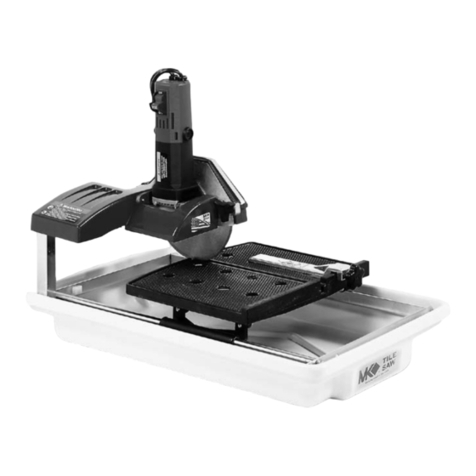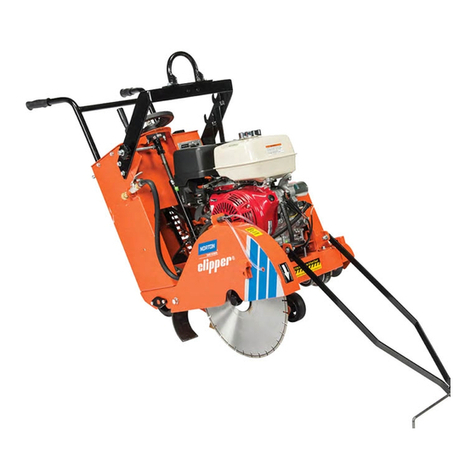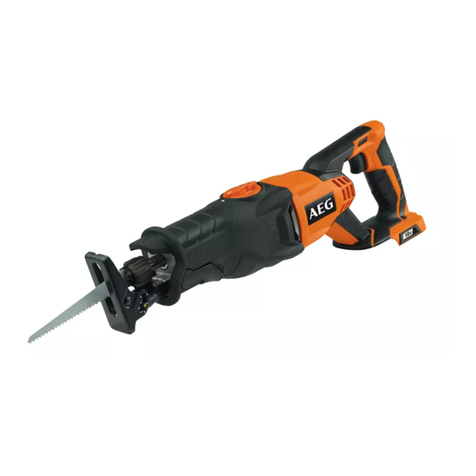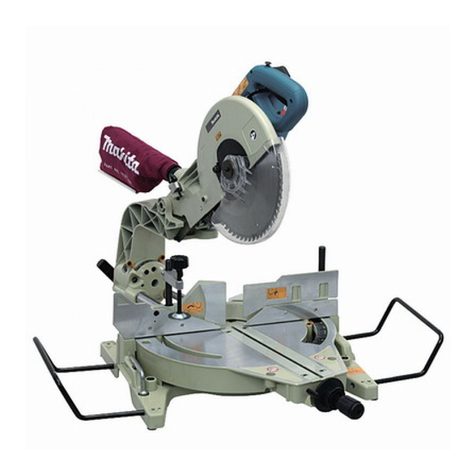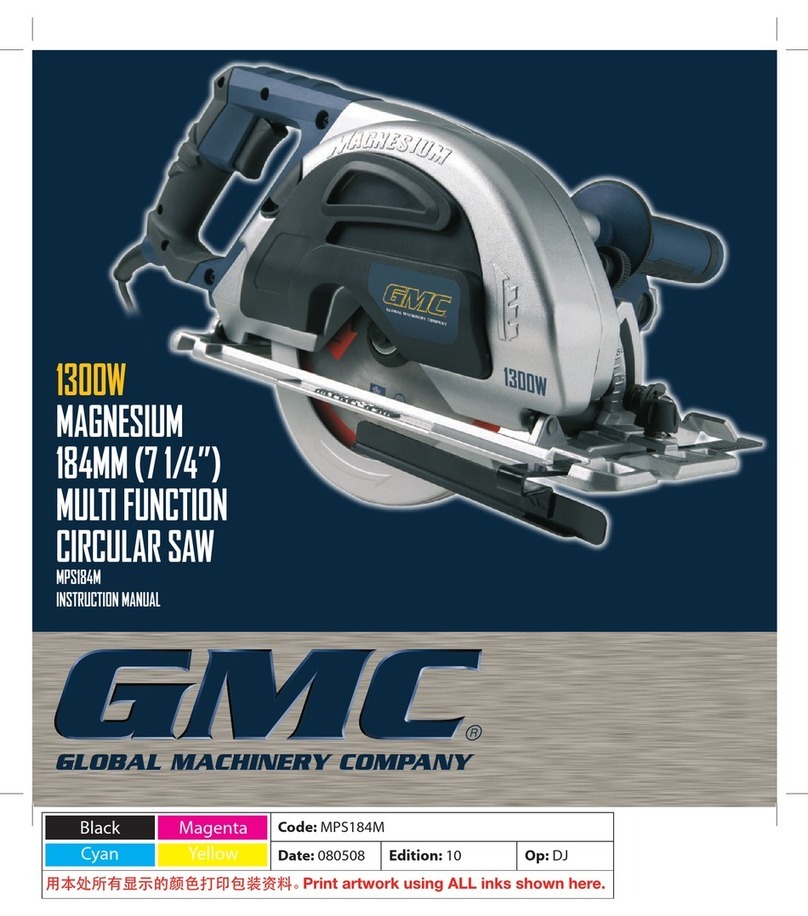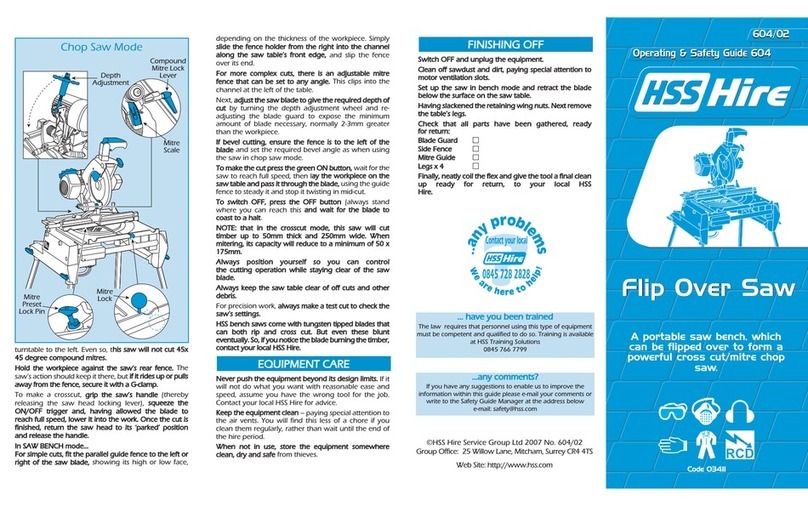SWISS TEC ST-227 MBS M User manual

Operating Instructions and Parts Manual
Metal Band Saw
Model ST-227 MBS M/ ST-227 MBS T
Revision A 1/2012

CE-Conformity Declaration
Product: Metal Band Saw
ST-227 MBS M/ ST-227 MBS T
Article Number: 77.915.91520.11/ 77.915.91520.12
Brand: SWISSTEC
Manufacturer:
DKSH Hong Kong Limited
23/F Tower A, Southmark, 11 Yip Hing Street, Wong Chuk Hang, Hong Kong
On our own responsibility we hereby declare that this product complies with the regulations
* 2006/42/EC Machinery Directive
* 2004/108/EC EMC Directive (Electro Magnetic Compatibility)
* 2006/95/EC Low Voltage Directive
* 2002/95/EC RoHS Directive (Reduction of Hazardous Substances)
designed with consideration of the standards
** EN 12100-1, EN 12100-2, EN 294, EN 349, EN 13898, EN 55014, EN 60204-1
Technical file compiled by: Marcel Baumgartner, General Manager Sourcing – Technology
2011-12-15 Marcel Baumgartner, General Manager Sourcing – Technology
DKSH Hong Kong Limited
23/F Tower A, Southmark, 11 Yip Hing Street, Wong Chuk Hang, Hong Kong
1

Table of Contents Page No
1 Warning...….………………………………………………………………..…
2 Safety rules for all tools….……………………………………………………
3
3 Specification….……………………………………………………………...…
3
4 Transportation of machine...……………………………………………….…
6
5 Installation ……………………………………………………………………..
6
6 Minimum room space for machine operation…..……………………………
7 Assembly………………………………………………………………………..
8 Operation…..…………………………………………………………………...
9 Blade guide bearing adjustment……..………………………………………..
10 Blade track adjustment….…………………………………………………….
7
7
8
9
12
13
14
15
16
18
11 Maintenance …………………..……………………………………………….
12 Lubrication …………………………………………………………………….
15 Trouble Shooting ………………………………………………………………
16 Circuit Diagram ……………………….………………………………………
Switch
Interlock switch
Guide adjustable knob Motor pulley cover
Blade adjustable knob
Hand vise wheel
Stop block
Cylinder
Vise jaw bracket
2

WARNING: FAILURE TO FOLLOW THESE RULES
MAY RESULT IN SERIOUS PERSONAL INJURY
As with all machinery there are certain hazards involved with operation and use of the machine.
Using the machine with respect and caution will considerably lessen the possibility of personal
injury. However, if normal safety precautions are overlooked or ignored, personal injury to the
operator may result.
This machine was designed for certain applications only. We strongly recommends that this
machine NOT be modified and/or used for any application other than for which it was designed. If
you have any questions relative to its application DO NOT use the machine until you contact with
us and we have advised you.
Always install the plastic belt cover before operating the machine.
SAFETY RULES FOR ALL TOOLS
A. USER:
(1). WEAR PROPER APPAREL. No loose clothing, gloves, rings, bracelets, or other jewelry to
get caught in moving parts.
Non-slip foot wear is recommended. Wear protective hair covering to contain long hair.
(2). ALWAYS WEAR EYE PROTECTION. Refer to ANSLZ87.1 standard for appropriate
recommendations.
Also use face or dust mask if cutting operation is dusty.
(3). DON'T OVERREACH. Keep proper footing and balance at all times.
(4). NEVER STAND ON TOOL. Serious injury could occur if the tool is tipped or if the cutting
tool is accidentally contacted.
(5). NEVER LEAVE TOOL RUNNING UNATTENDED. TURN POWER OFF. Don't leave
tool until it comes to a complete stop.
(6). DRUGS, ALCOHOL, MEDICATION. Do not operate tool while under the influence of
drug, alcohol or any medication.
(7). MAKE SURE TOOL IS DISCONNECTED FROM POWER SUPPLY. While motor is
being mounted, connected or reconnected.
(8). ALWAYS keep hands and fingers away from the blade.
(9). STOP the machine before removing chips.
(10). SHUT- OFF power and clean the BAND SAW and work area before leaving the machine.
B. USE OF MACHINE:
(1). REMOVE ADJUSTING KEYS AND WRENCHES. Form habit of checking to see that
3

keys and adjusting wrenches are removed from tool before turning it "on".
(2). DON'T FORCE TOOL. It will do the job better and be safer at the rate for which it was
designed.
(3). USE RIGHT TOOL. Don't force tool or attachment to do a job for which it was not
designed.
(4). SECURE WORK. Use clamps or a vise to hold work when practical. It's safer than using
your hand frees both hands to operate tool.
(5). MAINTAIN TOOLS IN TOP CONDITION. Keep tools sharp and clean for best and safest
performance. Follow instructions for lubricating and changing accessories.
(6). USE RECOMMENDED ACCESSORIES. Consult the owner's manual for recommended
accessories. The use of improper accessories may cause hazards.
(7). AVOID ACCIDENTAL STARTING. Make sure switch is in “OFF” position before
plugging in power cord.
(8). DIRECTIONOF FEED. Feed work into a blade or cutter against the direction of rotation of
the blade or cutter only.
(9). ADJUST AND POSITION the blade guide arm before starting the cut.
(10). KEEP BLADE GUIDE ARM TIGHT, A loose blade guide arm will affect sawing
accuracy .
(11). MAKE SURE blade speed is set correctly for material being cut.
(12). CHECK for proper blade size and type.
(13). STOP the machine before putting material in the vise.
(14). ALWAYS have stock firmly clamped in vise before starting cut.
(15). GROUNDALL TOOLS. If tool is equipped with three-prong plug, it should be plugged
into a three-hole electrical receptacle. If an adapter is used to accommodate atwoprong receptacle,
the adapter lug must be attached to a known ground. Never removed the third prong.
C. ADJUSTMENT :
MAKE all adjustments with the power off. In order to obtain the machine. precision and correct
ways of adjustment while assembling, the user should read the detailed instruction in this manual.
D. WORKING ENVIRONMENT:
(1). KEEP WORK AREA CLEAN. Cluttered areas and benches invite accidents.
(2). DON'T USE IN DANGEROUS ENVIRONMENT. Don't use power tools in damp or wet
locations, or expose them to rain. Keep work area well-lighted.
(3). KEEP CHILEREN AND VISITIORS AWAY. All children and visitors should be kept a
safe distance from work area.
(4). DON’T install & use this machine in explosive, dangerous environment.
4

E. MAINTENANCE:
(1). DISCONNECT machine from power source when making repairs.
(2). CHECK DAMAGED PARTS. Before further use of the tool, a guard or other part that is
damaged should be carefully checked to ensure that it will operate properly and perform its
intended function check for alignment of moving parts, binding of moving parts, breakage of parts,
mounting, and any other conditions that may affect its operation. A guard or other part that is
damaged should be properly repaired or replaced.
(3). DISCONNECT TOOLS before servicing and when changing accessories such as blades, bits,
cutters, etc.
(4). MAKE SURE that blade tension and blade tacking are properly adjusted.
(5). RE-CHECK blade tension after initial cut with a new blade.
(6). TO RPOLONG BLADE LIFE ALWAYS release blade tension at the end of each work day.
(7).CHECK COOLANT DAILY Low coolant level can cause foaming and high blade
temperatures. Dirty or week coolant can clog pump, cause crooked. Cast, low cutting rate and
permanent blade failure. Dirty coolant can cause the growth of bacteria with ensuing skin
irritation.
(8). WHEN CUTTING MAGNESIUM NEVER use soluble oils or emulsions(oil-water mix) as
water will greatly intensify any accidental magnesium chip fire. See your industrial coolant
supplier for specific coolant recommendations when cutting magnesium.
(9). TO PRNMT corrosion of machined surfaces when a soluble on is used as coolant, pay
particular attention to wiping dry the surfaces where fluid accumulates and does not evaporate
quickly, such as between the machine bed and vise.
F. SPECTIFIED USAGE:
This machine is used only for general metals cutting within the range of cutting capacity.
G. NOISE:
A weighted sound pressure level : 80 dB.
H. SAFETY DEVICE:
By the time the saw arm cover is opened, the interlock switch will function to stop the
machine. do not remove this switch from machine for any reason, and check it's function
frequently.
5

3. SPECIFICATION
Model ST-227 MBS M ST-227 MBS T
Article Numbe
r
77.915.91520.11 77.915.91520.12
Mains 230V ~1/N/PE 50Hz 400V ~3/PE 50Hz
Output Power 0.75 kW (1HP), S1 0.75 kW (1HP), S1
Reference Current 5.5 A 1.9 A
Extension Cord (H07RN-F) 3x1,5mm² 4x1,5mm²
Installation Fuse Protection 10A 16A
Blade Speeds 26, 50, 73, 95 m/min.
Blade Size 27 x 0.9 x 2655 mm
Dimension LxWxH (mm) 1380x460x1050
N.W / G.W (kg) 160 / 185
○(mm) 229
0°□(mm) 178x305
○(mm) 150
Working Capacity
±45°□(mm) 127x150
Noise 80 dB MAX
4. TRANSPORTATION OF MACHINE:
Unpacking
1. Transportation to desired location before unpacking, please use lifting jack.(Fig. B)
2. Transportation after unpacking, please use heavy duty fiber belt to lift up the machine.
Fig. B
ALLWAYS KEEP PROPER FOOTING & BALANCE WHILE MOVING THIS MACHINE.
6

5. INSTALLATION:
This machine weights 155 kg. It is recommended that the machine shall be transported, with help
of lifting jack.
Transportation Recommendation:
(1). Tighten all locks before operation.
(2). ALWAYS Keep proper footing & balance while moving this 155kgs machine, and only use
heavy duty fiber belt to lift the machine as Fig. A
(3). TURN OFF the power before wiring, & be sure
machine in proper grounding, Overload & circuit
breaker is recommended for safety wiring.
(4). CHECK carefully if the saw blade is running in
counter-clockwise direction if not , reverse the
wiring per circuit diagram then repeat the running
test.
(5). KEEP machine always out from sun, dust, wet,
raining area. 912(B.G)
6. MINIMUM ROOM SPACE FOR MACHINE OPERATION
7

7. ASSEMBLY
Counterclockwise rotation is required. Note that rotation can be reversed by following direction
given on terminal or nameplate.
(1). Assemble the motor mounting plate to the head using the long bolt Note that the flat side of
the plate faces up.
(2). Assemble the guard plate to the head using the screw and Lock Washer and the Carriage Bolt
Washer and Wing Nut are used to secure the motor mounting plate to the Guard plate through the
slotted hole in the Guard plate. These components also serve to position and lock the motor in
place for proper speed/ belt adjustment.
(3). Place the spacer over the long Bolt and secure it wit the nut.
(4). Secure the Motor to the Motor Mounting plate with the four bolts and nuts. Note, that the
motor shaft is placed through the large opening in the Guard plate and must be pareallel with the
drive Shaft.
(5). Assemble the Motor Pulley, the smaller of the two provided, to the motor shaft Note, the
larger diameter must be closest to the motor.
Do not tighten the set screw.
(6). Assemble the Driven Pulley, the larger of the two provided, to the protruding drive Shaft Note
the small diameter must be closest to the bearing.
Do not tighten the set screw.
(7).Place the belt into one of the pulley grooves and the other end into the respective grooves of
the second pulley.
(8) Line up the belt and both pulleys such that the belt is running parallel in the pulley grooves.
(9).Tighten the set screws of both pulleys in this position.
(10). Place the belt into proper pulley combination for proper blade speed. See material cutting
Chart.
(11). Adjust the position of the Motor to obtain approximately 13 mm depression in the belt when
applying pressure with your thumb.
(12). Tighten the head screw Holding the Motor Mounting plate to the Guard plate.
(13). Connect the Electrical Harness to the motor terminal box. The motor should be protected
with a time delay fuse or circuit breaker with a rated amperage slightly greater than the full load
amperage of the motor.
8

8. OPERATION
WORK SET UP
(1). Raise the saw head to the highest position.
(2). Open vise to accept the Piece to be cut by rotating the wheel at the end the base.
(3). Place workpiece on saw bed. If the piece is long, support the end.
(4). Clamp workpiece securely in vise.
WORK STOP ADJUSTMENT
(1). Loosen the thumb screw holding the work stop casting to the shaft.
(2). Adjust the work stop casting to the desired length position.
(3). Rotate the work stop to as close to the bottom of the cut as possible.
(4). Tighten thumbscrew.
(5). DO NOT ALLOW the blade to rest on the work while the motor is shut off.
BLADE SPEEDS
When using your Band saw always change the blade speed to best suit the material being cut
the material Cutting Shirt givers suggested settings for several materials.
Belt Groove Used
Material Speed(m/min.) Motor
Pulley
Saw
Pulley
Tool, Stainless
Alloy Steels
Bearing Bronze
26 Small Largest
Medium Large
Medium to High
Carbon Steels
Hard Brass or Bronze
Low to Medium
Carbon Steel
Soft Brass
50
73
Large Medium
Aluminum ,Plastic 95 Largest Small
BLADE DIRECTION OF TRAVEL BLADE MOVEMENT
Blade Direction
9

TELLTALE CHIPS
Chips are the best indicator of correct feed force. Monitor chip information and adjust feed
accordingly.
Thin or powdered chips – increase feed rate or reduce band
speed.
Burned heavy chips – reduce feed rate and/or band speed.
Curly silvery and warm chips – optimum feed rate and band
speed.
STARTING SAW:
1. Switch button function description.
(Start Button)
(
Sto
p
Button
)
(Emergency Push Button)
(Coolant Selection Switch)
CAUIION: NEVER OPERATE SAW WITHOUT BLADE GUARDS IN PLACE.
10

Be sure the blade is not in contact with the work when the motor is started. Start the motor, allow
the saw to come to full speed, then begin the cut by letting the head down slowly onto the work.
DO NOT DROP OR FORCE. Let the weight of the saw head provide the cutting force. The saw
automatically shuts off at the end of the cut.
CHANGING BLADE
Raise saw head to the highest position and open the blade guards. Loosen tension screw knob
sufficiently to allow the saw blade to slip off the wheels. Install the new blade with teeth slanting
toward the motor as follows:
(1). Place new blade and make sure the teeth are pointing the cutting direction.
(2). Turn the blade tension knob clockwise until the proper blade tension is achieved.
(3). Install the blade guards.
(4). Place 2-3 drops of lightweight oil on the blade.
TRU- LOCK VISE SYSTEM INSTRUCTIONS
(a)
(b)
(1) (2) (3)
(1) The position of the vise when tightened.
(2) The position of the vise when loosened. (Half opened)
(3) The position of the vise when loosened. (Completely opened)
To operate, proceed as follows:
1) Rise the arm about 50mm above the workpiece, close the cylinder valve to maintain the arm
above the workpiece.
2) Put your workpiece on the table. Move the vise handle (a) upwards to an angle of 45 degree
(a-Half opened) to loosen the vise.
Move the vise jaw bracket against the workpiece by turning the rectangular handle (b). Push
down on the vise handle (a) to lock the workpiece in position.
3) To loosen the workpiece from the vise, hold the workpiece and lift the vise handle (a) to a 90
degree position (completely opened). Remove workpiece.
QUICK VISE ADJUSTMENT FOR ANGLE CUT
(1). Loosen the A. B. C. D. Screws.
(2). Adjust rear vise to the threaded hole position (E).
(3). Set the scale to the desired angle.
11

(4). Adjust the front vise (F) to parallel the rear vise (E).
(5). Tighten the A. B. C. D. Screws.
9. BLADE GUIDE BEARING ADJUSTMENT
ATTENTION: This is the most important adjustment on your saw. It is impossible to get
satisfactory work from your saw if the blade guides are not properly adjusted. The blade guide
bearings on your metal. Cutting Band Saw are adjusted and power tested with several test cuts
before leaving the factory to insure proper setting The need for adjustment should rarely occur
when the saw is used properly. If the guides do get out of adjustment though, it is extremely
important to readjust immediately. If improper adjustment in maintained, the blade will not cut
straight, and if the situation is not corrected it will cause serious blade damage. Because guide
adjustment is a critical factor in the performance of your saw, it is always best to try a new blade to
see if this will correct poor cutting before beginning to adjust. If a blade becomes dull on one side
sooner than the other, for example, it will begin cutting crooked. A blade change will correct this
problem the guide adjustment will not. If a new blade does not correct the problem, check the blade
guides for proper spacing.
NOTE: There should be from 0 (just touching) to 0.03mm clearance between the blade and guide
bearings to obtain this clearance adjust as follows:
1. The inner guide bearing is fixed and cannot be adjusted.
2. The outer guide bearing is mounted to an eccentric bushing and can be adjusted.
3. Loosen the nut while holding the bolt with an Allen wrench.
4. Position the eccentric by turning the bolt to the desired position of clearance.
5. Tighten the nut.
6. Adjust the second blade guide bearing in the same manner.
REMARK:
1. Adjust the tension of blade until the back of the blade (A) against the blade wheel (front)
lightly.
2. Be sure the nut (E) is tightened.
3. Turn the eccentric shaft (B) counterclockwise, when the bearing (D) touches the saw blade
properly, tighten the nut (E).
12

4. To adjust, loosen socket head screw (F) and move the blade adjustable up or down until it
lightly touches the back of the blade (A).
5. The carbide blade guides (L) Fig.1,should also be adjusted so they lightly touch the blade
by loosening screws (M).
6. Repeat 1. 2, 3, 4and 5 steps to adjust the other side's blade guide bearings (G).
7. Correct the base and blade to be a vertical position by using a straight edge. If necessary,
loosen set screw (F).
8. Set down the blade frame, correct the jaw vise (H) and blade to be a vertical position with a
Straight edge, then tighten the screws (I).
9. Loosen screw (K), move front jaw vise (J) to against rear jaw vise (H) tightly, then tighten
the screw (K).
A C
M
D
G L
Fig.2
Fig.1
10. BLADE TRACK ADJUSTMENT
(1). Open the blade guard.
(2). Remove the blade guide assemblies (top and bottom)
(3). Loosen the hex head screw in the tilting mechanism to a point where it is loose but snug.
(4). With the machine running, adjust both the set crew and blade tension knob simultaneously to
keep constant tension on the blade. The set screw and blade tension knob are always turned in
opposite directions, ie, when one is turned clockwise the other is turned counterclockwise.
The blade is tracking properly when the back side just touches the shoulder of pulley or a
slight gap appears near the center line of the pulley. Care should be taken not to over-tighten
the saw blade since this will give a false adjustment and limit life of the blade.
(5). Tighten the hex head screw in tilting mechanism. IMPORTANT: Sometimes in trying to
make this critical adjustment it is possible to cause the basic setting to be misaligned. Should
this occur, proceed as follows:
a. Loosen the set screw and back it out as far as it can go and still remain in the threaded hole.
b. Turn the hex head screw clockwise until it stops (do not tighten).
c. Turn the set screw clockwise until it bottoms, then continue for half a turn and check the
13

tracking by turning on the machine.
d. If further adjustment is required, go back to step 4.
(6). Turn off power to the machine.
(7). Replace the blade guide assemblies--it may be necessary to loosen the blade tension lightly.
(8). Adjust the vertical position of blade guide bearing assemblies so that the back side of the
blade just touches the ball bearing.
(9). Make a final run to check tracking. It required, touch up adjustment (See stop 4)
(10). Replace the blade guards.
Hydraulic Feed Adjustment
(1) To adjust the feeding rate when in cutting, turn the volume valve clockwise for faster feeding,
counterclockwise for slower feeding.
(2) When cutting feed is too fast, raise the saw arm, then slower the feed rate to prevent blade
damage.
11. MAINTENANCE
CAUTION: MAKE CERTAIN THAT THE UNIT IS DISCONNECTED FROM THE POWER
SOURCE BEFORE ATTEMPTING TO SE RV ICE OR REMOVE ANY COMPONENT.
That's easier to keep machine in good condition or best performance by means of maintaining it at
any time than remedy it after it is out of order.
(1) Daily Maintenance (by operator)
(a) Fill the lubricant before starting machine everyday.
(b) If the temperature of spindle caused over-heating or strange noise, stop machine immediately
to cheek it for keeping accurate performance.
(c) Keep work area clean; release vise, cutter, work-piece from table; switch off power source;
take chip or dust away from machine and follow instructions lubrication or coating rust proof
oil before leaving.
(2) Weekly Maintenance
(a) Clean and coat the leading screw with oil.
(b) Check to see if sliding surface and turning parts lack of lubricant. If the lubricant is
insufficant, fill it.
(3) Monthly Maintenance
(a) Check if the fixed portion has been loose.
(b) Lubricate bearing, worm, and worm shaft to avoid the wearing.
(4) Yearly Maintenance
14

(a) Adjust table to horizontal position for maintenance of accuracy.
(b) Check electric cord, plugs, switches at least once a year to avoid loosening or wearing.
12. LUBRICATION
Lubricate the following components with grease.
(1). Vise lead screw.
(2). Vise guide ways
(4). The drive gears run in an oil bath and will not require a lubricant change more often than once
a year, unless a leak or over-hot occur.
Changing gearbox oil:
Fill the gear box with approximately 0,350 liters of Mobil Gear 634 ( ISO VG 460) gear oil or
equivalent.
15

13. TROUBLE SHOOTING
Symptom Possible Cause(s) Corrective Action
Excessive Blade
Breakage
1. Materials loosen in vise.
2. Incorrect speed or feed
3.Blade teeth spacing too large
14. Material too coarse
5. Incorrect blade tension
6.Teeth in contact with material
before saw is started
7. Blade rubs on wheel flange
8. Miss-aligned guide bearings
9. Blade too thick
10 Cracking at weld
1. Clamp work securely
2. Adjust speed or feed
3. Replace with a small teeth
spacing blade
4. Use a blade of slow speed
and small teeth spacing
5. Adjust to where blade just
does not slip on wheel
6. Place blade in contact
with work after motor is
starred
7. Adjust wheel alignment
8. Adjust guide bearings
9. Use thinner blade
10. Weld again, note the weld
skill.
Premature Blade Dulling 1. Teeth too coarse
2. Too much speed
3. Inadequate feed pressure
4.Hard spots or scale on material
5. Work hardening of material.
6.Blade twist
7. Insufficient blade
8. Blade slide
1. Use finer teeth
2. Decrease speed
3. Decrease spring tension on
side of saw
4. Reduce speed, increase feed
pressure
5. Increase feed pressure by
reducing spring tension
6. Replace with a new blade,
and adjust blade tension
7. Tighten blade tension
adjustable knob
8. Tighten blade tension
Unusual Wear on
Side/Back of Blade
1.Blade guides worn.
2.Blade guide bearings not adjust
properly
3.Blade guide bearing bracket is
loose
1.Replace.
2.Adjust as per operators
manual
3.Tighten.
16

Teeth Ripping from
Blade.
1. Tooth too coarse for work
2. Too heavy pressure; too slow
speed.
3. Vibrating work-piece.
4. Gullets loading
1. Use finer tooth blade.
2. Decrease pressure, increase
speed
3. Clamp work piece securely
4. Use coarser tooth blade or
brush to remove chips.
Motor running too hot 1. Blade tension too high.
2. Drive belt tension too high.
3. Blade is too coarse for work
4. Blade is too fine for work
5. Gears aligned improperly
6. Gears need lubrication
7. Cut is binding blade
1. Reduce tension on blade.
2. Reduce tension on drive belt.
3. Use finer blade.
4. Use coarse blade.
5. Adjust gears so that worm is
in center of gear.
6. Check oil path.
7. Decrease reed anti speed
Bad Cuts (Crooked) 1. Feed pressure too great.
2. Guide bearings not adjusted
properly
3. Inadequate blade tension.
4. Dull blade.
5. Speed incorrect.
6. Blade guides spaced out too much
7. Blade guide assembly loose
8. Blade truck too far away from
wheel flanges
1. Reduce pressure by
increasing spring tension on
side of saw
2. Adjust guide bearing, the
clearance can not greater
than 0.001.
3. Increase blade tension by
adjust blade tension
4. Replace blade
5. Adjust speed
6. Adjust guides space.
7. Tighten
8. Re-track blade according to
operating instructions.
Bad Cuts (Rough) 1. Too much speed or feed
2. Blade is too coarse
3. Blade tension loose
1. Decrease speed or feed.
2. Replace with finer blade.
3. Adjust blade tension.
Blade is twisting
1. Cut is binding blade.
2. Too much blade tension.
1. Decrease reed pressure.
2. Decrease blade tension.
17

CIRCUIT DIAGRAM
18

19
This manual suits for next models
1
Table of contents







